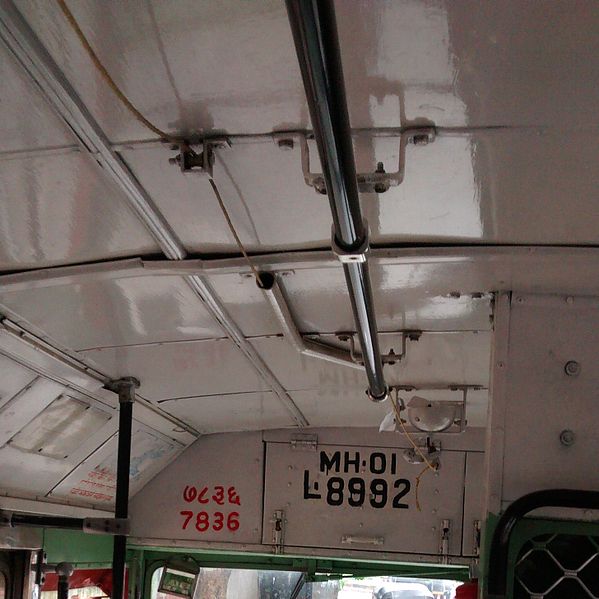So, how do Bus Conductors tell the bus driver to start the bus, and stop the bus at a bus stop?
There are various ways. In this article, I’m going to explore the different ways they are done, as well as delve a bit into the operations of buses of two non Indian cities, where a conductor doesn’t ask for a bus to be stopped, but the passenger does.
So let me start with our Desi transcos.
Starting, in no particular order:
BEST, NMMT, PMPML
The BEST Model also applies to NMMT, TMT, MBMT, PMPML, and partly to MSRTC.

Here, there is a bell next to the driver, with a bell-pull that goes upto the back of the bus. The rope of the bell pull is looped through several hoops, enabling the conductor to pull it from wherever he is standing. He pulls the rope and the bell rings. A single ring signifies stop, and a double ring signifies go. In MSRTC buses, especially at night, a double ring while the bus is in motion is to inform the driver to switch off or switch on the lights. Since BEST AC buses have only a front door functional, the driver knows when to stop or move the bus, while in the case of NMMT and TMT, the rear doors rarely open.
MSRTC
This is very prevalent in the Hirakani [Asiad] buses. It is similar to the bell-pull, but with a twist. Instead of a bell, an electric bell is installed near the Driver. A wire casing runs along the roof of length the bus, with bell switches after every three seats. The conductor presses the switch once for stop, twice for go, and twice in motion for the lights.
BMTC and KSRTC
One of the most interesting methods, no bus of BMTC has ever had a bell pull for the last decade. The conductor here, tells the driver to stop or move. He or she yells, that’s right, yells! The phrases used are Hold for stop and Right for go. Of course, Hold often sounds like Hold It, or Whole Day, and Right sounds like a Britisher saying the word, with stress on the ‘r’ and the ‘ight’ sounding like ‘oit’. This happens in the Vajra as well. Few conductors carry a whistle with them, blow it once for stop and twice for go, but most of them prefer shouting it out.
MTC and TNSTC
Older MTC and TNSTC buses had a bell pull in them, with the same ringing order as BEST. However, newer buses, especially the semi-low floor buses that came with the advent of JnNURM buses didn’t have these. In these buses, the conductor officially carries a whistle, and blows it; once for stop and twice to go.
DTC
DTC is a unique case. The conductor doesn’t tell the driver to stop or go. The driver stops, and looks at the mirror and leaves. However, this does get a bit confusing, given that nobody in Delhi seems to follow the enter from the rear, exit from the front rule. I wonder how the driver manages.
And now, for something completely different …
MTA
Metropolitan Transit Authority [MTA] buses in New York have a system where the passenger tells the driver that he or she wants to disembark at the next stop, since there is no conductor. How I wish, the BMTC was a bit smarter in this regard.
If you are a fan of the 1990s Nickelodeon animated TV show Hey Arnold!, you would notice that in the very first episode, Downtown as Fruits, you’d notice that Gerald refrains from pulling the bell-pull to indicate the stop.
MTA buses used to have a bell-pull along the length of the bus, next to the window, which a passenger could pull to indicate that they wanted to disembark at the next stop. These were subsequently phased out in 1980, with a yellow touch-sensitive tape on the walls that passengers would use instead. Once considered a relic of the bygone era, they made a comeback in 2009. Many a passengers were surprised, especially the old-timers, who were overjoyed on seeing something from their generation return, followed by the youngsters, who had never seen them before.
TfL
Transport for London [TfL], which operates the red London bus, which is what BEST buses were originally modelled on, have a bell-switch on the support poles within a bus. Indian buses, most notably Tata Marcopolo buses also have these, but they are not in use.
Of course, knowing the British, it is not surprising when I heard of a driver who left a note saying BELLS NOT WORKING, If you want Bus to stop, Yell Ding Ding.
![]()

More often than not, in BMTC buses, you have to put up with the drool of the conductor flying into your face when he whistles.
Not to mention the whistle makes you deaf! 😀
Delhi Gurgaon is the most confusing. There have been times when the conductor has asked for the bus to stop. By tapping a coin on the bus window and shouting.